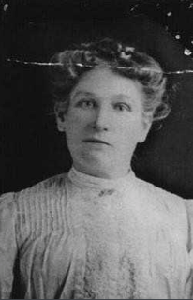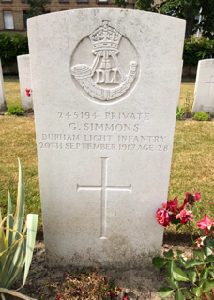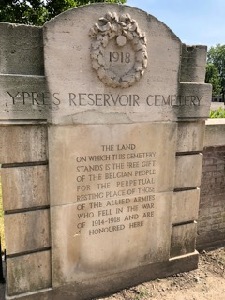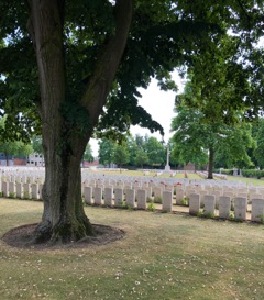
Henrietta Simmons

Ypres Reservoir Cemetery

Ypres Reservoir Cemetery

Ypres Reservoir Cemetery
Pauline Priano has submitted the following:-
George Simmons, one of 12 children of whom only 11 survived, was the 3rd born of 6 sons and had 6 younger sisters. His father John Simmons was born 1866 in Scotland, his mother Henrietta Gould was the daughter of Irish parents, Sergeant George Gould and his wife Elizabeth. Her parents were married November 26th 1861 at St. John’s Church, Kilkenny, Ireland, four years later her father was serving in India with the 36th Foot, she was born, April 5th 1867 in Moradabad, Bengal. Her parents returned to Ireland in 1873 before transferring the following year to Scotland.
John and Henrietta’s son John Jnr was born in 1885 at Wellshott Place, Rutherglen, Glasgow and William in 1887, however, they did not marry until October 1st 1888 just prior to the birth of George, born at Silverback, Cambuslang, Glasgow, October 8th 1888. In 1891 John, his wife, their 3 sons and new born daughter Elizabeth were living at Silverbacks Lorne Rest Buildings with his in-laws and Henrietta’s 5 siblings. The Simmons family had moved to the north east of England by 1900 having had a further 4 children James born May 15th 1892, Mary, March 31st 1894, Henrietta, March 2nd 1896, all born in Scotland, and Rhoda, June 23rd 1900 at Hebburn, County Durham. In 1901, living at 40, William Street, Hebburn, John supported his family employed as a copper smith’s labourer, John Jnr (16) worked as a rivet heater at the shipyard and William (14) was a shipyard messenger boy. Their family was complete by 1911 with the birth of Margaret, May 19th 1902, Albert, April 24th 1906, Agnes, January 1st 1908 and William, June 8th 1911 whilst they were living at 39, High Street, Hebburn. George’s father was employed as a plumber’s labourer at the shipyard, his wife ran her own laundry business from home, George (22) was an apprentice plater, James (18) a grocer’s assistant, Mary (17) worked as a domestic servant and with the exception of Albert (4) and Agnes (3) the younger children were scholars.
When war was declared George was living with his family at 13, Aln Street, Hebburn, employed as a plater’s helper. He presented himself in order to enlist at Hebburn, December 7th 1915, despite having been discharged from the 3rd Battalion (Special Reserve) Durham Light Infantry in 1911, deemed to be extremely slight and of poor physical development. On this occasion he was accepted and assigned to the Northumberland Fusiliers as Private 8863. The following day he was posted to the Army Reserve until September 17th 1916 when he was mobilised and trained for active service overseas. Private Simmons departed for the Western Front, June 16th 1917, landing at Boulogne, France, moving on to the 32nd Infantry Base Depot at Etaples for further training and trench familiarisation. June 5th 1917 Private Simmons was transferred to the 5th Battalion then on to the 12th Battalion Durham Light Infantry with a change of service number to Private 246917 joining his regiment that same day in the field on the Somme, attached to the 68th Brigade, 23rd Division.
July 7th 1916 the 12th Battalion entered the fighting south of La Boisselle, near Albert, spending most of August in reserve. October 7th, assisted by a tank they attacked and captured the Tangle, a complex of trenches and machine guns, east of Le Sars during the Battle of Le Transloy and captured 70 Germans with the loss of only 30 men killed and 80 wounded, they were then withdrawn and sent north to Belgium where they spent the rest of the winter 1916 and spring 1917 in the mud filled trenches of the Ypres salient. The tunnelling companies had been hard at work in the sector not an easy task as the soil in that area was sandy. The explosive filled tunnels were ignited under the German lines June 1917 on the Messines Ridge, the 12th Battalion advanced capturing Impartial trench with the loss of only 15 casualties and saw action again in September during the Third Battle of Ypres in fighting on the Menin Road.
Private 245194 George Simmons Durham Light Infantry was killed in action September 20th 1917, his body initially buried at map reference I. 24. d. 9. 2. and a cross placed on his grave with his military details. After the Armistice and subsequently the signing of the Treaty of Versailles which brought WW1 officially to an end, the huge task began to clear the battlefields and also to concentrate the dead from smaller cemeteries into larger ones. In 1921 the remains of Private 246917 George Simmons Durham Light Infantry were exhumed, identified by means of a wallet, as the cross on his grave had been destroyed during subsequent action in the sector and he was brought into Ypres Reservoir Cemetery, Ypres, Belgium for reburial with all honour and reverence by an Army chaplain. He is at rest grave X. E. 19, at the time of his demise in 1917 he was 28 years of age and single.
His father received all monies due to him and his awards of the British War Medal and Victory Medal sent to him at 13, Aln Street, Hebburn, County Durham.
Although three of his brothers were also eligible to serve during WW1 only the record of James Simmons, who served as infantry in the Machine Gun Corps, has been found. He survived the conflict and died in 1967.
The loss of George only added to his family’s grief as his mother had died April 28th 1917 aged 50 years, John Simmons died aged 76 years in 1942 at Nottingham, Nottinghamshire.
In God’s safe keeping. Rest in Peace.
George Simmons is not remembered at Hebburn.
He is remembered in The DLI Book of Remembrance as G. Simmonds on page 255

